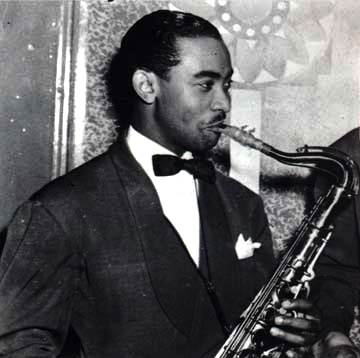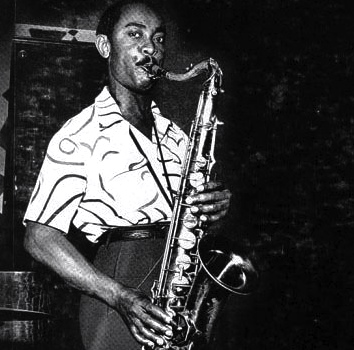Don Byas (tenor saxophonist) was born October 21, 1912 in Muskogee, Oklahoma and passed away on August 24, 1972 in Amsterdam, The Netherlands. Both of Byas’ parents were musicians. His mother played the piano, and his father, the clarinet. Byas started his training in classical music, learning to play violin, clarinet and alto saxophone, which he played until the end of the 1920s. Benny Carter, who played many instruments, was his idol at this time. He started playing in local orchestras at the age of 17, with Bennie Moten,Terrence Holder and Walter Page. He founded and led his own college band, “Don Carlos and His Collegiate Ramblers”, during 1931-32, at Langston College, Oklahoma.
Byas switched to the tenor saxophone after he moved to the West Coast and played with several Los Angeles bands. In 1933, he took part in a West coast tour of Bert Johnson’s Sharps and Flats. He worked in Lionel Hampton’s band at the Paradise Club in 1935 along with the reed player and arranger Eddie Barefield and trombonist Tyree Glenn. He also played with Eddie Barefield, Buck Clayton, Lorenzo Flennoy and Charlie Echols.
In 1937, Byas moved to New York to work with the Eddie Mallory band, accompanying Mallory’s wife, the singer Ethel Waters, on tour, and at theCotton Club. He had a brief stint with arranger Don Redman’s band in 1938 and later in 1939-1940. He recorded his first solo record in May 1939: “Is This to Be My Souvenir” with Timme Rosenkrantz and his Barrelhouse Barons for Victor. He played with the bands of such leaders as Lucky Millinder, Andy Kirk, Edgar Hayes and Benny Carter. He spent about a year in Andy Kirk’s band, recording with him between March 1939 and January 1940, including a short solo on “You Set Me on Fire”. In September 1940, he had an eight bar solo on “Practice Makes Perfect”, recorded by Billie Holiday. He participated in sessions with the pianist Pete Johnson, trumpeter Hot Lips Page, and singer Big Joe Turner. In 1941 at Minton’s Playhouse he played with Charlie Christian, Thelonious Monk and Kenny Clarke in after hours sessions.

In early 1941, after a short stay with Paul Bascomb, he had his big break when Count Basie chose him to succeed the post of Lester Young in his big band.
- “Harvard Blues”, Jimmy Rushing’s vocal version of George Frazier’s tune, recorded November 17
- July 24, 1942, small group session with Buck Clayton, Count Basie, and his rhythm section (Freddie Green, Walter Page, Jo Jones) recording “Royal Garden Blues” and “Sugar Blues”
- August 1942 went to Hollywood with Basie’s band to record for the film Reveille with Beverly
- January 1943, another film Stage Door Canteen
- November 1943, last recording with Basie
- Started to play in small bands in New York clubs
- He played with Coleman Hawkins at the Yacht Club (1944)
- Associated with Beboppers such as Dizzy Gillespie, Charlie Parker, George Wallington, Oscar Pettiford and Max Roach at the Onyx Club from early 1944
- Recorded with the above under Coleman Hawkins six sides, which are said to be the first bebop recordings: “Woody ‘n You”, February 16 and 22, 1944.
- May 1944, shared tenor duties with Hawkins in the latter’s “Sax Ensemble”
- May 1944 leader of his own band, performances at the “Three Deuces”
- Recorded for small labels (Savoy, Jamboree, National, Disc, Arista, Super, American, Hub, Gotham)
- Had a hit with “Laura” by David Raksin, the title tune of Otto Preminger’s movie of the same name (1944)
Despite his bebop associations, Byas always remained deeply rooted in the sounds of swing. He started out by emulating Coleman Hawkins, but Byas always cited Art Tatum as his greater influence: “I haven’t got any style, I just blow like Art”. January 4, 1945 – Clyde Hart, singer “Rubberlegs” Williams, Gillespie, Parker, Trummy Young.

- January 9, 1945: Gillespie, Byas and Young record “Be Bop”, “Salt Peanuts”, and “Good Bait” for Manor
- Town Hall concert, duet with Slam Stewart in 1945
- Savoy sessions in 1945-46
- January 11, 1946, Esquire magazine, 2nd place in tenor sax
- February 22, recorded with Gillespie, “52nd Street Theme”, “Night in Tunisia”
In September 1946 Byas went to Europe to tour with Don Redman’s big band in Denmark, Belgium, Switzerland, and Germany. They were the first all-black American orchestra to appear in the French capital since the liberation.Byas remained in Europe. After playing in Belgium and Spain, he finally settled in Paris, and was able to record almost immediately.
While still in Geneva he recorded “Laura” and “How High the Moon”. In December 1946 he recorded for the first time in France, with Redman, Tyree Glenn and Peanuts Holland. He recorded for the Swing and Blue Star labels in 1947, working with Eddie Barclay. In 1947 and 1948 Byas lived in Barcelona, where he moved to enjoy the lower cost of living and the thriving atmosphere.The pianist Tete Montoliu sneaked into the Copacabana Club in Barcelona to hear the great saxophone player.Byas was at the top of his form in these years, performing with Bernard Hilda’s orchestra (August 1947), Francisco Sanchez Ortega, and Luis Rovira.
He played with Bill Coleman in early 1949; touring that autumn with Buck Clayton. From 1948 onwards, Byas became a familiar figure not only around the Saint-Germain-des-Prés in Paris, but also on the Riviera, where he could be seen in Saint-Tropez sporting a mask, tuba, flippers and an underwater spear-gun. The tenor found work, could record regularly and had many friends. They adored not only his musical talent but his skills at the pool table, as a sportsman (fishing and diving) and a chef who who cooked Cajun and Creole food.
Byas played in the Andy Kirk band in 1939-40 and later in 1944. They recorded together on Vogue in 1953. Byas also recorded with Beryl Booker in the same year.

Byas relocated to the Netherlands and married a Dutch woman. He worked extensively in Europe, often with such touring American musicians as Art Blakey, Kenny Clarke, Duke Ellington, Dizzy Gillespie, Jazz at the Philharmonic, Bud Powell, and Ben Webster. He also recorded with Fado singer Amália Rodrigues during his time in Europe. Byas did not return to the U.S. until 1970, appearing at the Newport Jazz Festival.
Byas’ style evolved in the lush, rococo, full-bodied tenor tradition of Coleman Hawkins, but his sound was unmistakably his own, immediately recognizable. A master of technique, he accomplished both the tenderest warmth and the most strident sting. His sense of drama coupled with a brilliant use of dynamics and timbre, a deeply-felt romanticism–which on occasion dripped into sentimentality, his worst pitfall–and an unsurpassable sense of swing made his improvisations unique.
Byas was a masterful swing player with his own style, an advanced sense of harmony, and a confidence and adventurousness that found him hanging around the beboppers and asking to play. He held his own and did so while insistently remaining himself: he never picked up the rhythmic phrases, the lightning triplets, that are indigenous to bop. Yet Charlie Parker said of him that Byas was playing everything there was to play.
Byas died in Amsterdam in 1972 from lung cancer, aged 59.
Byas’ Dolnet tenor saxophone (purchased from his widow) is on display at Rutgers University’s Institute of Jazz Studies.
Byas was inducted into the Oklahoma Jazz Hall Of Fame in 1997.
